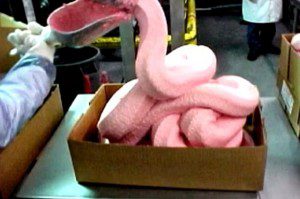 The controversy over so-called “pink slime” ground beef is repulsive on one level but also serves as a teaching moment about the value of eating halal.
The controversy over so-called “pink slime” ground beef is repulsive on one level but also serves as a teaching moment about the value of eating halal.
Here is how the beef industry defines pink slime:
The lower-cost ingredient is made from fatty bits of meat left over from other cuts. The bits are heated and spun to remove most of the fat. The lean mix then is compressed into blocks for use in ground meat. The product is exposed to ammonium hydroxide gas to kill bacteria, such as E. coli and salmonella.
And here’s how federal food safety microbiologists describe it:
The term ‘pink slime’ was first coined in 2002 by Food Safety Inspection Service microbiologist Gerald Zirnstein, who toured a Beef Products Inc. production facility. Zirnstein later emailed his colleagues and told them he did not “consider the stuff to be ground beef,” according to the online news site.
Pink slime is a mix of ground-up connective tissue and beef scraps that are normally meant for dog food. BPI’s Lean Beef Trimmings are then treated with ammonia hydroxide to kill salmonella and E. coli, and mixed into ground beef or hamburger.
“We originally called it soylent pink,” Carl Custer, another microbiologist with the Food Safety Inspection Service, told The Daily. “We looked at the product, and we objected to it because it used connective tissue instead of muscle. It was simply not nutrionally equivalent (to ground beef). My main objection was that it was not meat.”
And here is an analysis from Scientific American about the relative nutritional value:
An analysis conducted at Iowa State University (A.S. Leaflet R1361) found two-and-a-half times more insoluble protein (77% vs. 30%) relative to soluble proteins in ordinary ground chuck. Nutritionally, our gut bacteria digest much of what we cannot, but there’s a good bet that we can’t get as much value from insoluble proteins (collagen and elastin, found largely in tendons, ligaments, and cartilage) as from their soluble siblings (myosin and actin, usually associated with muscle tissues). While these proteins may be hard to digest, on the plus side, there’s less fat in LFTB (~5%) than standard ground chuck (15-20%).
Most of the media attention to pink slime was driven by a Change.org petition started a few weeks ago by a Houston blogger, Bettina Siegel. She writes of the controversy and her role:
When I started my Change.org petition on March 6th, I had one simple, clearly defined goal: to ask USDA to revisit its practice of providing school districts with ground beef containing LFTB. The USDA/schools petition went viral, garnering almost a quarter of a million signatures in a little over a week (and now exceeding that target). USDA responded to the outpouring of concern by offering schools the option of buying beef without this filler. And that might have been the end of this story.
But clearly something else arose out of my petition and the media coverage associated with it. Consumers learned — many for the first time — that USDA allows LFTB to be mixed into the nation’s ground beef supply, up to 15%, without any labeling to disclose that fact. Reportedly, 70% of beef in this country now contains LFTB.
And as it turns out, consumers are quite unhappy about this fact.
Some people are concerned about food safety, given the pathogenic nature of the raw material used by BPI to make the product. Its safety record, though now admirable, was somewhat more troubling between 2005 and 2009 when E. coli and salmonella were repeatedly found in its product, as reported by the New York Times. Some consumers – rightly or wrongly — worry about the use of ammonium hydroxide in the processing of their food. Some people consider the inclusion of an unlabeled filler to be a form of economic adulteration, in that their package labeled 100% ground beef might only be 85% ground chuck or ground round and the rest a gelatinous meat filler. And others claim there are aesthetic differences between beef with LFTB and pure ground beef.
Whether any or all of these concerns are valid is almost beside the point. Our free market is founded on informed consumer choice, but in this case USDA deprived consumers of the ability to make that choice when it made the controversial decision to treat LFTB as “ground beef,” no different from ground chuck or ground round.
That’s the key issue here – informed consumer choice. And there certainly are economic inequities here – organic-grown ground beef has more nutritional value and tastes better, but is almost twice as expensive as beef containing pink slime, even if both are labeled as “80% lean” (the former will be composed of cuts of meat that are 20% fat. The latter will be much higher-fat cuts mixed with pink slime). This is part of the vicious cycle of poverty and poor health, which is a topic all to itself (beyond my scope here, but read this about “food deserts” in urban cities if you’re interested).
The problem is that even with a successful campaign to inform consumers, there is no guarantee in the future that the beef or chicken you buy is free of questionable additives like pink slime. The only way to be completely certain that your meat is really meat, is to go the organic route, and among organic options the single best organized and reliable brand is Halal.
Related: My halal butcher of choice is Fresh Market, located at 601 W. North Avenue in Villa Park IL. If you happen to shop there, mention that you were recommended by City of Brass 🙂 If you’re looking for halal dining, then Zabihah.com is your best bet (and they have a mobile app). My favorite Halal restaurant in Madison is Olivas. Finally, I buy all my vitamins from KosherVitamins.com and Douglas Labs. I have no affiliation with these sites, they are just awesome.

